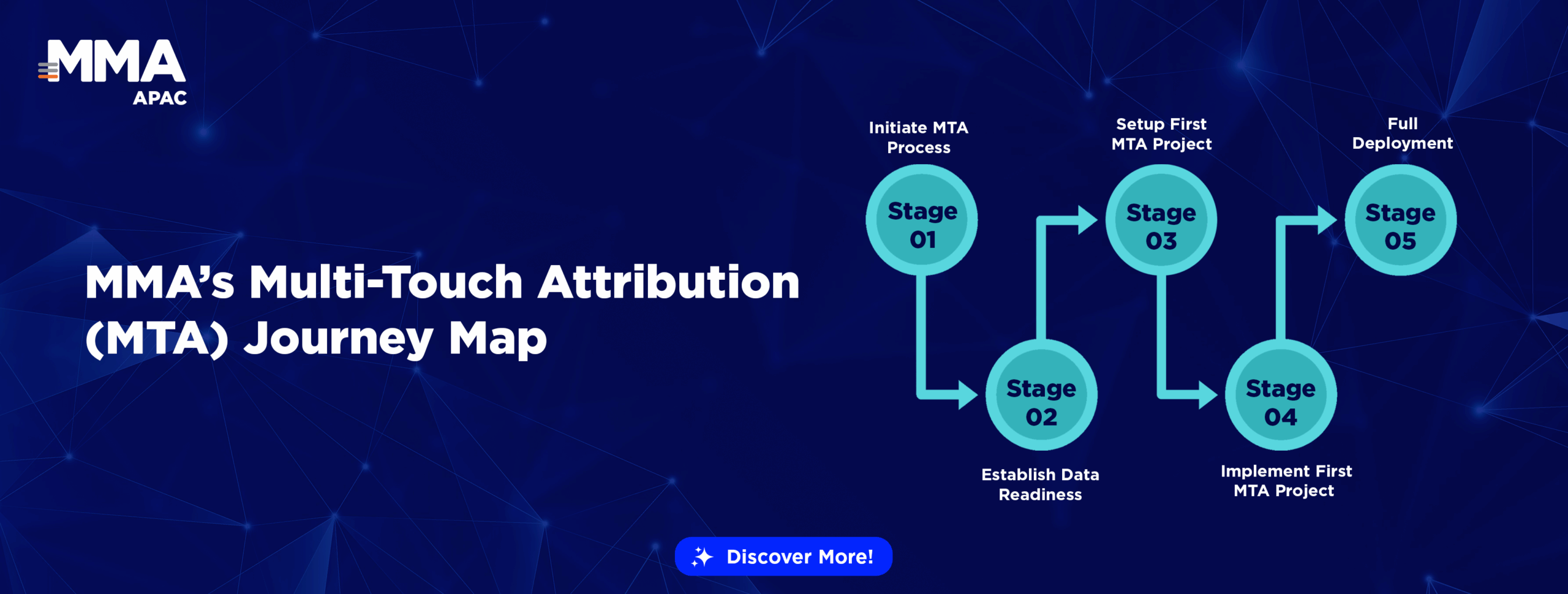
The MMA Multi-Touch Attribution (MTA) Journey Map is an end-to-end guide on how to launch a successful multi-touch attribution initiative within an organization, which based on feedback gathered through the Marketing Attribution Think Tank (MATT) working groups.
The MTA Journey Map spotlights three rollout traps, the “data ditch” of endless data wrangling, the “forever-pilot” loop of tests that never scale, and the “slow-evolution” stall caused by waiting for perfect data or integration, and guides teams to bypass them by accepting good-enough inputs, confronting resistance, and launching at pace toward full MTA adoption.

Stage 1: Initiate MTA Process
This stage involves understanding the benefits of MTA to your organization, determining the scope, identifying key stakeholders, and gaining internal agreement to move forward.
It also includes building an initial business case covering value, action plan, costs, and resources. Creating a cross-functional team (Analytics, media, Data, CRM, legal, market research) and building organization consensus on the value proposition are part of this stage, alongside managing data privacy issues. You also finalize the commitment for testing, including budgets, responsibilities, timeline, and coverage percentages. Setting test goals for what success looks like, such as incremental learning, proving ROI improvement, and ease of working with the provider, is also done here. Foundational knowledge of MTA analytics is important.
Stage 2: Establish Data Readiness
This stage focuses on determining whether you have the necessary data, especially conversion data, to allow MTA models to be created.
It requires a deep review of linkable data like ad serving and CRM, confirming the availability of linkable conversion data, and planning for non-linkable data.
Data is a critical component of MTA. A key stage in the MTA journey is Establish Data Readiness, which involves determining whether you have the necessary data, especially conversion data, to allow MTA models to be created. This stage requires a deep review of linkable data, such as ad serving and CRM data, to confirm that linkable conversion data is available. An approach for non-linkable data or deciding to ignore it should also be considered.
However, data presents significant challenges for MTA success. Data-related issues impede MTA for 89% of marketers surveyed. The top specific data-related issues identified are:
- Data Quality (56%)
- Data Access (50%), which includes challenges with Walled Gardens or GDPR regulations and User Identity
- Data Linkage (40%), involving Unified ID’s, connecting data across devices and platforms, and linking to CRM
Illustration above is a reference to rework

Stage 3: Setup First MTA Project
This stage involves setting up your first MTA project, including brand and campaign selection, as well as selection of MTA provider.
It’s described as your first and best chance to make a good impression on the value of MTA. This involves managing the project plan. You also need to assess media and data partners’ capabilities to share data with independent MTA firms. Identifying the analytics needed for “must-haves,” creating a plan for proving incrementality, and considering modelling options (e.g., digital or omnichannel, integrated or pure MTA) are part of setting up. Issuing the Request for Information (RFI) to evaluate and choose an MTA provider (or decide to build in-house) is also key.
Stage 4: Implement First MTA Project
This stage involves implementation of your first MTA project, including evaluation of the performance of your MTA provider and value of MTA tor your organization.
Activities include evaluating the performance of your MTA provider and the value of MTA to your organization. You also need to document lessons learned from this first project, contrast MTA results to other models, and learn to use the MTA provider’s dashboard. Assessing the MTA provider includes evaluating the dashboard’s usability, timeliness, transparency, and cost.
Stage 5: Full Deployment
In this final stage, MTA is fully integrated into your media planning process.
The aim is to maintain and expand the perceived value of MTA to the organization. This involves the on-going evaluation of model effectiveness, staying alert for emerging methods, and documenting situations for successful MTA and its value-add. Solidifying and scaling the relationship with your MTA provider is crucial. A deployment plan is created, identifying brands and regions that would benefit and outlining a phased rollout.

